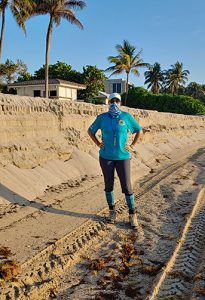For many, 2020 has not been a fantastic year. I too share the feelings of isolation, loneliness, and loss. However, as an eternal optimist, I always try to find a positive in a seemingly negative situation. Despite the last six months of the “new normal”, I found and treasured a few nuggets of joy along the way.
One of those was the opportunity to assist the Miami-Dade County Sea Turtle Conservation Program (MDCSTCP) as a surveyor. MDCSTCP holds the permit from the Florida Fish and Wildlife Conservation Commission to perform all sea turtle nesting surveys and related activities including hatchling releases, nest excavations, and stranding responses in Miami-Dade County. While I had a little bit of previous sea turtle experience, it was 1) a really long time ago (7 years), and 2) a completely different experience. Coming to this program was a new learning curve for me, but fortunately, the highly experienced Program Manager and senior staff were patient and taught me lots.
Sea turtle nest monitoring is hard work. First of all, Miami-Dade County is responsible for almost 20 miles of beach: very large areas that requires driving a Utility Task Vehicle (UTV) on the sand. My previous turtle survey work was done by foot, on beaches that were much smaller. Learning how to drive the UTV was a little scary, especially on Haulover Beach where there are three-foot escarpments (read: a cliff made out of sand) that you may have to drive down if you can safely do so. It feels wrong to be driving a vehicle on the sand at all, but I did adjust after a while. It was also incredible to see how much the same beach changed from day-to-day: the way that the sand moves and the tides affect an area is just incredible.

Most people don’t realize that we aren’t looking for actual sea turtles, but rather, signs of them. We are looking for the tracks left behind by the female turtle as she crawls onto the beach from the ocean. We are looking for signs of her nest, or whether she false crawled (came ashore but returned to the water without digging a nest and depositing her eggs). As the season progresses, we are looking for the signs that the nest hatched. All of this work becomes more complex as you factor in the beach cleaners who are waiting for you to finish your survey so that they can proceed, the sun rising earlier, making it hotter more quickly, driving the UTV as close to the high tide line as possible but avoiding big holes, people sleeping on the beach, other wildlife, etc. We are also tasked with excavating the nests to determine success, which is gritty and hot work. Every single piece of information that you could think of must be recorded.

However, the payoff: finding a hatchling during an excavation, or performing hatchling release under the night sky, when it’s safest for the hatchlings to make their 3-11 mile trip out into the Gulf Stream is worth it. When I began training, I jokingly said to my colleagues “I’m in it for the sunrises.” While the sunrises were breathtaking and never alike, I was really in it for the conservation and protection of the turtles. This opportunity to be on the front lines, so to speak, allowed me to get fresh air during a time that was otherwise stifled, and from a distance, educate members of the community about the great work the MDCSTCP accomplishes. It is estimated that 1 out of 1,000 hatchlings makes it to adulthood. Although 2020 has been a tough year for all of us, knowing that I’ve helped a few of those hatchlings on their way gives me hope for what lies ahead.
 0
0
